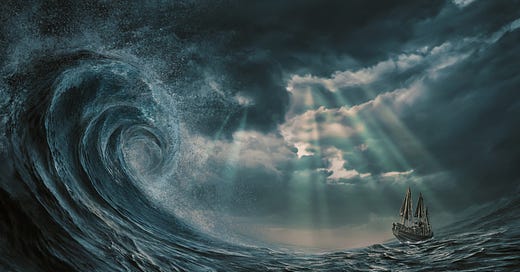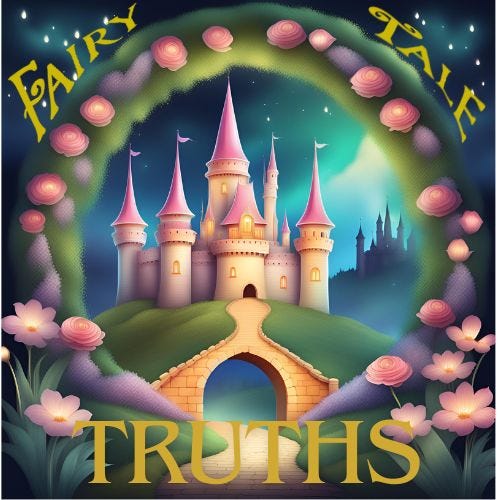“Born at sea in the teeth of a gale, the sailor was a dog. Scuppers was his name.”1
So begins the much-loved story of a dog, his ship and the sea. Written by Margaret Wise Brown in 1953, and published by Golden Books Publishing Company, The Sailor Dog* tells the tale of one isolated soul, Scuppers the dog, making his way on the mighty sea. Of special note, this Little Golden Book was illustrated by renowned artist, Garth Williams, who also did the artwork for Stuart Little, Charolotte’s Web and the Little House series of books.
As the month of August draws to a close, let’s return to the sea one more time and read through this children’s story using the Four Senses.
1. Literal Sense: What does the story say?
We know from the first page that Scuppers is born at a difficult time. He enters the world “in the teeth of a gale.”2 Even though he doesn’t stay at sea, the ocean nevertheless claims a special place in his heart. Scuppers grows up on a farm, but once he’s old enough he looks for a way to return to the sea.
He sees a train, but no, that won’t do. Then he sees a car, but that’s no good either. So, he goes “over the hills and far away” to the sea, where he hears the call “All Aboard!” He climbs on board and returns to the sea
His small sailboat moves away slowly at first and Scuppers is careful to keep everything shipshape. He puts his hat “on the hook for his hat, and his rope on the hook for his rope, and his pants on the hook for his pants, and his spyglass on the hook for his spyglass, and he puts his shoes under the bed and got into his bed, which was a bunk, and went to sleep.”3
Unfortunately for Scuppers, he is soon shipwrecked. The ship crashes onto the rocks and he is washed overboard, “hurled by giant waves onto the shore.”4 He finds himself on an uninhabited island, but he unearths a buried treasure - an old-fashioned toolbox with everything he needs to build himself a little home, with a “door and a window and a roof and a porch and a floor, all out of driftwood.” He even finds some discarded red bricks and builds a chimney. He’s all set to survive his new life, so he jumps into his bed of pine branches, goes to sleep and dreams that “If he could build a house, he could mend the hole in the ship.” So, the next day, that’s just what he does.
He once again sets sail on the sea, but this time, he realizes that his clothes need to be replaced so he stops in a foreign port and outfits himself, even buying a bag of oranges, a new rope and a new, clean handkerchief.
The story ends with Scuppers once again at the helm of his small craft, putting out into the deep, with one hand holding fast to his new rope and the other holding his new telescope, peering out across the waves. He is “where he wants to be - a sailor sailing the deep green sea.”
2. Spiritual Sense A - Allegorical: What does the story mean?
In a nutshell, The Sailor Dog is an allegory of the spiritual journey.
From the beginning, none of us have any ability to choose the family, country, or situation we are born into. We simply arrive where we are. Although circumstances vary, each of us is born into some type of “gale,” because we are all born into a fallen world, where the right thing and the good thing and the just thing do not automatically occur. Like Scuppers, we arrive in “the teeth of a gale.” And, like Scuppers, we pass through childhood and arrive on the threshold of adulthood. At this moment, there is really one question to ask ourselves, “Will I try to embrace my vocation or run from it?”
Everyone has a vocation, because, at its broadest understanding, the word vocation refers to the universal call to holiness. Everyone, not just a few select persons, is called to holiness - to be whole, and set apart for a relationship with God, participating in the re-ordering of creation. But we each also have a specific path we are called to follow, based on the gifts and talents that God has given us. We are supposed to make a return of these gifts, so that they can be purified and multiplied.5 The particular vocational path of some may be to the priesthood or religious life, others to marriage or to the single life. Beyond the state of life we choose, we also have to decide how we will work to contribute to the common good. Our individual, personal vocation finds its place within the larger, universal call to holiness. So, Scuppers realizes that he is called back to the sea, that his life’s work is not on the land or even under the sea. He is going to set out on a small bark, and “put out into the deep.” (Luke 5:4-11)

The illustrations showing Scupper’s small craft do not inspire confidence. The sails are patched and torn and the wood of the boat itself looks warped and worrisome. Is this boat even seaworthy? Regardless of whether it is or not, Scuppers jumps aboard, unhesitant and eager, and sails off all alone.
Isn’t this exactly how we respond to the call to holiness in the beginning? We are confident that God is with is and all will be well, that we can face anything. Everyone goes through this honeymoon stage. Things are great and golden until, suddenly, they are not. The wild, terrible storm will undoubtedly appear. Even if we weather one or two of these storms in our small bark, “the big one” will eventually show up and knock us flat. We will be hurled by “giant waves,” finding ourselves in a new place, struggling to survive. This could be a new place materially and physically, or it might be psychologically or spiritually. Or even all of them together!
As unpleasant as these storms are, they are not only part of the spiritual journey, but they are also vital to it. Without these terribles trials, we will never overcome ourselves, grow in relationship with God, and mature as apostles and disciples. This is what happens to Scuppers.
When he wakes up on the deserted island, he knows he has to build a shelter first so that he can survive. He finds the buried toolbox, itself a symbol of the tools we need to build our house - prayer, Scripture, sacraments, community. It’s not until after Scuppers has completed this task that he receives instructions in a dream, much like Joseph.
Why does Scuppers gain clarity in his dream? After all, it seems pretty obvious that if he can build a house, then he can use those same tools to fix his boat. Yet, Scuppers is apparently blind to this. Why? Because he has been changed by his trial. We don’t know that Scuppers knew how to use a hammer and saw before he had to build his makeshift house. It may well be that it was only because he had to figure out, and quickly, how to use those tools buried in the sand that he gained the skills to then be able to repair his boat. The trial was necessary for his growth, for his change.
That Scuppers has indeed changed is seen very quickly, as the story tells us that soon after repairing his boat and sailing away, he realizes his clothes have been destroyed. Although he is the only person on the boat, he still sees that his outside needs to change to reflect his inside.
Having characters change their outward clothing to signify an interior change is often seen in literature.6 We do the same thing in our sacraments. Girls and boys wear white dresses and special clothes on their First Communion Day, men take on the collar and vestments during Holy Orders, women might take on the habit of their order during their vows of profession. In the case of the sacraments, the outward clothing symbolizes a new way the person will relate to God. There is a change. Something unseen has happened that is represented visually outside.
Scuppers puts into a foreign port, a place he is now able to navigate thanks to his new disposition. He goes into a clothing store and tries on several different hats and shoes, before settling on ones that are “just right,” ironically, both the hat and the shoes are white.
Because Scuppers has matured, he knows that he also needs to take care of his body, so buys a bag of oranges.7 He has a new eye for practicality, wisdom gained through experience, so he buys a new rope. And he also buys a fresh, clean handkerchief, to remind himself to stay disciplined and ordered.
He returns to his boat, newly restored and refitted, and takes up his post once again, sailing the high seas and listening to the call from the deep. We leave Scuppers as he is singing:
I am Scuppers the Sailor Dog- I'm Scuppers the Sailor Dog- I can sail in a gale right over a whale under full sail in a fog. I am Scuppers the Sailor Dog- I'm Scuppers the Sailor Dog- with a shake and a snort I can sail into port under full sail in a fog.
3. Spiritual Sense B - Moral: How does the story teach us to act?
This story teaches us two things. Firstly, of the inevitability of trials and tribulations in our lives. Not only can we count on having them, but we are called to see them from a certain perspective, to see them as what they are; building-up exercises on our path up the mountain to the house of our Father. This is certainly not easy to do in the moment. But God reminds us to put our faith in him, saying:
do not fear, for I am with you;
do not be dismayed, for I am your God.
I will strengthen you and help you;
I will uphold you with my righteous right hand. (Isaiah 41:10)
Even more than that, we are to cry out to the Lord for help. “Our Lord, who is God, showed that he wished people to lay their requests before him. He let people ask him and keep on asking”8 for their petitions to be granted. It is when we feel most alone, like Scuppers, shipwrecked on the island, that we need to turn to him in prayer, asking for guidance and clarity.
Secondly, this tale reminds us that we do not face our trials alone. In fact, we don’t even put out to sea on our own, even if we may think we do. God sets out with us, and he goes on the journey with us. “Imagine two men sharing a ship’s cabin on a voyage. It would be unnatural for them not to speak to one another. But suppose one of the men was completely dependent on the other - for his food, to be dressed and undressed, to be moved about, and suppose the other cared for him with the utmost devotion…That is exactly our position in regard to God. He is not only always with us on our voyage through life, but we are completely dependent upon him for our very being and even for every breath we breathe.”9
God does not abandon us, but he doesn’t do everything for us, either. Scuppers had to do the hard work of building his house with a few tools and driftwood. He had to sweat under the sun, toiling away, probably thirsty and hungry. The house didn’t just magically appear. God goes with us through the shipwrecks in our lives, but we still have to do some hard work ourselves, so that our trials change us into the people we are meant to be.
4. Spiritual Sense C - Anagogical or Eschatological Sense: How does the story point us forward, to our end?
Christ in the Storm by Ludolf Bakhuizen, 1695, Wiki commons
Mark 4:34-41 relates the well-known story usually referred to as “Jesus Calms the Storm.” This short passage describes both the apostles’ tremendous fear, as well as Jesus’ ability to master the elements and bring calmness and order out of events that are spiraling out of control.
Scripture reads:
A furious squall came up, and the waves broke over the boat, so that it was nearly swamped. 38 Jesus was in the stern, sleeping on a cushion. The disciples woke him and said to him, “Teacher, don’t you care if we drown?”
39 He got up, rebuked the wind and said to the waves, “Quiet! Be still!” Then the wind died down and it was completely calm.
40 He said to his disciples, “Why are you so afraid? Do you still have no faith?”
41 They were terrified and asked each other, “Who is this? Even the wind and the waves obey him!” (Mark 4:37-41)This scene reminds us that God can do things we can’t. Although Jesus is traveling with us, even in the very same boat as the apostles, we still have to ask him for help. God gives us free will, and that includes letting us try to cope with things on our own or responding to our cries. From the Scriptures above, we can surmise that it took the apostles a while before they decided to wake Jesus, even waiting until they thought they were going to drown. After all, a full-blown storm doesn’t just suddenly appear. It builds up over time. Perhaps the apostles knew Jesus was tired, since he had spent all day teaching to the crowd, and, out of kindness, let him sleep. Maybe they underestimated the storm itself and thought they could handle things on their own. Since they were experienced fishermen, they must have known how to read the weather.
But regardless of the reason, Jesus responds quickly and decisively, not rebuking them for waiting until things got really out of hand. Instead, he chastises them for being afraid and fearful, and for assuming he doesn’t care.
Ultimately, this Scripture passage and the tale of Scuppers, the sailor dog, remind us of our need to stay close to God through the voyage of our lives, calling upon him for guidance as well as assistance, remembering that we do not journey alone, so that we can find our way through the storms and the trials of life, arriving safely home at the house of the Father.
*The book is available on Amazon, where you can take a look inside at the first few pages and see Garth William’s delightful illustrations. Also, I need to let you know that this is an affiliate link. If you purchase the book after clicking this link, I receive a small commission, and you’ll get a wonderful book!
Margaret Wise Brown, The Sailor Dog, 1
Ibid
Ibid
Ibid
This is the teaching behind the Parable of the Talents in Matthew 25:14-30, where the one servant who does nothing but bury his talent in the backyard is severely chastised.
Herman Melville in particular liked to use this technique in his works Redburn and Moby Dick.
For generations, sailors were struck down by a mysterious illness called “scurvy.” It was caused by a lack of Vitamin C. Once this was known, oranges, packed full of Vitamin C, were kept on board and became a symbol of health and wellness. They still signify this today.
Canon Francis J. Ripley, quoted in Magnificat, July 2024, p.269
Ibid.











Can I give this a million 'likes'? I'm not exaggerating when I say this is brilliant! I love that book Scuppers (and, in fact, I need to go out and buy not just one but multiple copies of it because ours has disappeared). There was always something about this story that I was drawn to, and that part when he realizes, "If he could build a house, he could mend the hole in the ship," always stood out to me. I love the way you connect all the imagery in the story to the spiritual life.